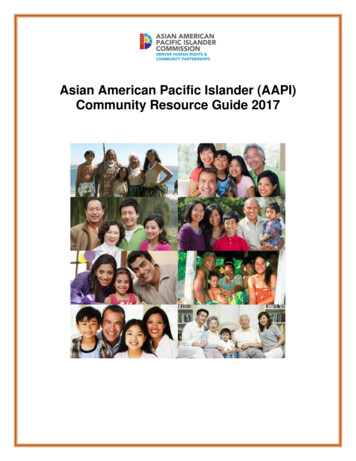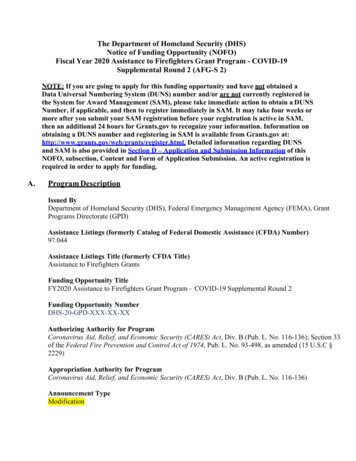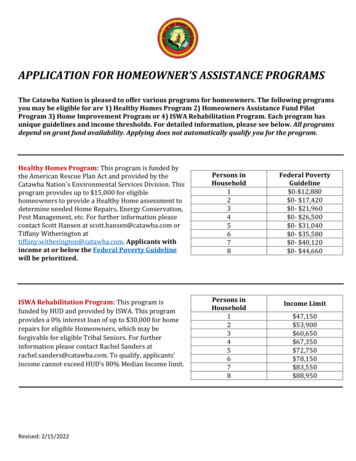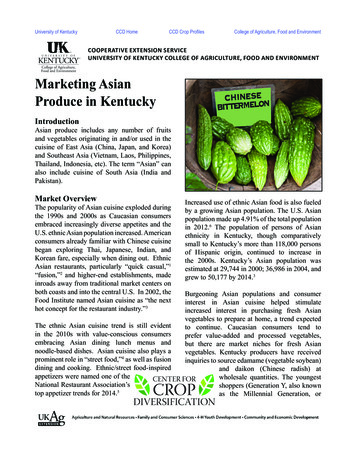
Transcription
Technical Assistance ReportProject Number: 51252-006Knowledge and Support Technical Assistance (KSTA)December 2021Kingdom of Bhutan: Supporting Financial Sector ReformsThis document is being disclosed to the public in accordance with ADB’s Access to InformationPolicy.
CURRENCY EQUIVALENTS(as of 18 November 2021)Currency unitNu1.00 1.00– ngultrum (Nu) 19NPLRMATAAsian Development Bankcoronavirus diseasenonperforming loanRoyal Monetary Authoritytechnical assistanceNOTEIn this report, “ ” refers to United States dollars.Vice-PresidentDirector GeneralDeputy Director GeneralDirectorShixin Chen, Operations 1Kenichi Yokoyama, South Asia Department (SARD)Manmohan Parkash, SARDSabyasachi Mitra; Public Management, Financial Sector, andTrade Division (SAPF); SARDTeam leaderManohari Gunawardhena, Senior Financial Sector Specialist,SAPF, SARDMa. Kristina Hidalgo, Senior Financial Sector Officer, SAPF,SARDMaria Charess Pabatao, Senior Operations Assistant, SAPF,SARDTeam membersIn preparing any country program or strategy, financing any project, or by making any designationof or reference to a particular territory or geographic area in this document, the AsianDevelopment Bank does not intend to make any judgments as to the legal or other status of anyterritory or area.
CONTENTSPageKNOWLEDGE AND SUPPORT TECHNICAL ASSISTANCE AT A GLANCEI.INTRODUCTION1II.ISSUES1III.THE TECHNICAL ASSISTANCEA.Impact and OutcomeB.Outputs, Methods, and ActivitiesC.Cost and FinancingD.Implementation Arrangements33345IV.THE PRESIDENT'S DECISION5APPENDIXES1.Design and Monitoring Framework62.Cost Estimates and Financing Plan93.List of Linked Documents10
Project Classification Information Status: CompleteKNOWLEDGE AND SUPPORT TECHNICAL ASSISTANCE AT A GLANCESupporting Financial Sector ReformsDepartment/DivisionProject Number: 51252-006SARD/SAPFNature of ActivityModalityResearch and DevelopmentRegularExecuting AgencyMinistry of FinanceCountryBhutan1. Basic DataProject Name2. SectorFinanceSubsector(s)Finance sector developmentADB Financing ( million)0.50Total0.50qq3. Operational PrioritiesAddressing remaining poverty and reducing inequalitiesAccelerating progress in gender equalityTackling climate change, building climate and disasterresilience, and enhancing environmental sustainabilityStrengthening governance and institutional capacitySustainable Development GoalsSDG 1.bSDG 5.bSDG 8.10SDG 10.4SDG 13.a4. Risk Categorization LowClimate Change InformationGHG Reductions (tons per annum)Climate Change impact on the ProjectADB FinancingAdaptation ( million)Mitigation ( million)0.000Low0.030.03CofinancingAdaptation ( million)Mitigation ( million)Gender Equity and MainstreamingEffective gender mainstreaming (EGM)0.000.00Poverty TargetingHousehold TargetingQq5. Safeguard CategorizationSafeguard Policy Statement does not applyqq6. FinancingModality and SourcesADBKnowledge and Support technical assistance: Technical AssistanceSpecial FundCofinancingNoneCounterpartNoneTotalAmount ( million)0.500.500.000.000.000.000.50Currency of ADB Financing: US DollarqSource: Asian Development BankThis document must only be generated in eOps.08122021204813910642Generated Date: 08-Dec-2021 20:48:27 PM
I.INTRODUCTION1.This knowledge and support technical assistance (TA) will help deliver financial sectorreforms in Bhutan through assisting the Royal Monetary Authority (RMA) to (i) improve financialsystem stability which will result in strong financial institutions; (ii) equip RMA as the regulator ofall financial institutions with skills to deliver focused risk-based supervision of the financial systemwhich will help strengthen weak areas of the system; and (iii) guide financial institutions to offerbetter designed products to the public and increase inclusiveness through providing access andproducts.2.The TA is closely aligned with the following operational priorities of Strategy 2030 of theAsian Development Bank (ADB):1 (i) addressing remaining poverty and reducing inequalities, and(ii) strengthening governance and institutional capacity.2 The TA builds on the experience andprior interventions of ADB such as the TA provided under Financial Market Development Program(Subprogram 2), where a nonperforming loan (NPL) resolution strategy was formulated for banksand nonbanks and the TA provided for Supporting Financial Stability in Bhutan and the Maldivesin 2012-2015.3II.ISSUES3.Institutional and regulatory framework. The RMA is the regulator of all the financialinstitutions in Bhutan. The RMA used a compliance-based supervision approach until 2019, whenit converted to a risk-based supervision approach (i) to ensure that it employs a structured processthat identifies (a) the most critical risks faced by an individual financial institution (both banks andnonbanks), and (b) systemic risks in the financial system; and (ii) work towards gradualcompliance with international market standards laid down by Basel III and relevant sections of theInternational Association of Insurance Supervisors (full compliance expected by calendar end2023). The main challenges during the transitional period are (i) training, skill formation, andredeployment of RMA staff as required; and (ii) development of a robust risk-based supervision(RBS) system. This TA focuses on strengthening supervision by the RMA, managing systemicrisk, and improving asset quality and financial inclusion covering all financial institutions.4.Banking industry. Bhutan’s finance sector comprises five banks. Total assets in thebanking sector were about 2.82 billion (74.39% of the total finance sector) as of September2021.4 Capital adequacy ratio declined from 15.10% in December 2019 to 13.90% in December2020 due to credit risk. NPLs, increased from 8.50% in December 2017 to 11.00% in December2020. Banking industry’s NPLs by sector in December 2020 consisted of trade and commerce(20.90%) and service and tourism (20.70%), production and manufacturing (16.06%) and housing(14.90%). Liquidity ratio is 31.70% (the required statutory ratio is 20.00%).5.Banking industry shortcomings. The risk of concentration (housing and construction) ishighly prevalent because of the narrow economy. Credit growth accelerated following the Indianrupee crisis-led credit decline in 2012. Moreover, high bank exposure in vulnerable sectors,particularly housing (27.4% in December 2020), can be a source of risk in the medium term1234ADB. 2018. Strategy 2030: Achieving a Prosperous, Inclusive, Resilient and Sustainable Asia and the Pacific. Manila.The TA first appeared in the business opportunities section of ADB’s website on 26 November 2021.ADB. 2020. Technical Assistance to the Kingdom of Bhutan for Strengthening the Financial Market DevelopmentProgram. Manila; ADB. 2012. Technical Assistance for Supporting Financial Stability in Bhutan and the Maldives.Manila; and ADB 2021. Report and Recommendation of the President on Financial Market Development(Subprogram 3).Government of Bhutan, RMA. 2021. Highlights on the Financial Sector Performance: September 2021. Thimphu.
2because it may prompt the buildup of a real estate bubble. NPLs have risen along with high creditgrowth, which reflects credit underwriting weaknesses and delays in collateral enforcement. Inaddition, mismatches in assets and liabilities may be a source of vulnerability, when a largerportion of the deposit base is short term, seasonal, and volatile, while credit is usually long term.Bhutan is partially compliant with Basel II banking regulations. Capital adequacy is aligned withBasel III regulations, while the liquidity coverage ratio is only monitored and not enforced.6.Weakening asset quality and pressure on capital. The coronavirus disease (COVID19) pandemic exposed the underlying risks of the finance sector on NPLs, which were highbecause of high credit growth in the pre-pandemic period; credit increased at a 5-year compoundannual growth rate of 20% from 2014 to 2019. This resulted in (i) lax credit underwriting, (ii)inadequate and insufficient verifiable valuations, and (iii) an inadequacy of internal riskmanagement systems, which have not kept up with the pace of credit growth. During thepandemic, COVID-19 relief measures were introduced by the RMA to the financial sector in twophases: deferment of loan principal and interest payments, extension of repayment periods ofproject loans and concessional loans to the cottage and small industries sector and tourismsector, and a continuation of the same measures until the middle of 2022. The pressure on theperformance of the banking industry resulting from the pandemic will continue over a protractedperiod. A further reduction in capital adequacy levels is anticipated. The nonbanking segment willbe similarly challenged, with falling credit growth and rising NPLs. This will be aggravated by anincrease in defaults on life insurance premiums caused by job losses, impacting insurancecompanies.7.Nonbanking segment. Bhutan’s nonbanking segment comprises two insurancecompanies, one reinsurance company, and the National Pension and Provident Fund. Totalassets of the nonbanking sector were 0.97 billion (25.62% of the total finance sector) as ofSeptember 2021 (footnote 4). The segment is thinly capitalized, with a total capital adequacy ratioof 10.14% in December 2020 (compared to 9.41% in December 2019), marginally above theregulatory requirement of 10.00%. Its liquidity ratio is at 16.40% (the regulatory ratio is 10.00%).Asset quality deteriorated from 6.03% in December 2017 to 22.15% in December 2020. The RoyalInsurance Corporation of Bhutan and the Bhutan Development Bank contributed significantly tothe overall NPLs of the finance sector (footnote 4). In 2020, the NPL ratio in the nonbanking sectorimproved mainly because of loan deferment programs under the COVID-19 pandemic monetarymeasures. However, nonbank NPL ratios increased in all sectors as of December 2020, with theservice and tourism sectors sharing the highest at 43.21% followed by the trade and commercesector at 16.92% and the housing sector at 10.63%.8.Nonperforming loan resolution measures. The RMA has introduced a series ofmeasures under a nonperforming loan (NPL) resolution framework to address the rising NPLs.These include (i) guidelines for managing NPLs with foreclosure, write-off, capital management,and asset transfers provisions; (ii) establishment of a high-level committee consisting of financialinstitutions (including the governor of the RMA) and chaired by the finance minister, with amandate to study the NPL situation in depth and propose solutions; and (iii) loan defermentmeasures using a phased approach. Financial institutions (both banking and nonbanking) haverecognized the importance of risk management, including the strengthening of the risk-basedmonitoring system and continuous capacity building.9.Potential Climate Risk. ADB’s Country Partnership Strategy for Bhutan, 2019–2023identified climate risk across all three pillars of the CPS. Reforms to financial markets cut acrossthe dynamic economic reforms, improved connectivity and greater inclusiveness covered under
3the three pillars.5 Financial system stability and risk-based supervision will benefit from climaterisk assessment on a preliminary basis that could be built upon later to mitigate climate risk.10.Inadequate financial inclusion. Bhutan’s rural communities lack access to formalremittance services. Access to finance is still the biggest concern of private businesses and ruralentrepreneurs in Bhutan. RMA launched the Priority Sector Lending Guidelines in 2017, alongwith amendments to the Credit Information Bureau Rules and Regulations.6 The CreditInformation Bureau was established in September 2009.7 National Financial Inclusion Strategy(NFIS) of Bhutan defines financial inclusion as “the provision of appropriate financial products andservices at an affordable cost by formal financial service providers that meet the needs of theunserved and underserved segments of Bhutan’s population.”8 National Financial Literacy Survey(NFLS) is a collaborative strategic initiative of the RMA to promote financial knowledge,confidence, and consumer protection to the people of Bhutan.9 The purpose of the ConsumerProtection for Financial Services (CPFS) is to redress aggrieved consumers, promote fair tradepractices, and empower and enhance consumer confidence in financial services.10 All need to bestrengthened with effective reporting, enforcement of consumer protection with compensationframeworks, implementation support and monitored with supervision by RMA.Table 1: Financial Inclusion information as of December 2020Financial Inclusion IndicatorDecember 2020MenRatio of private sector credit to gross domestic product67.9% (15.4% in 2005)Adults with a savings account76.1%52.7%Adults access to credita21.8%57.2%Adults with life insurance25.3%59.6%a Lending against collateral is still the norm despite the establishment of the credit information bureau.III.A.Women47.3%42.8%40.4%THE TECHNICAL ASSISTANCEImpact and Outcome11.The TA is aligned with the following impacts: (i) innovation and financial technologyadvanced; (ii) stability and integrity of the financial system maintained (Twelfth Five Year Plan,2018–2023); and (iii) stable and inclusive economic recovery reinforced.11 The TA will have thefollowing outcome: capacity of the RMA for implementation of financial market reformsstrengthened.12B.Outputs, Methods, and Activities12.Output 1: Implementation of the insurance sector strategy strengthened. The TA willsupport the RMA in the implementation of recommendations in the insurance sector strategy toachieve market reforms including capacity building and training on benefits. Toward this, the TAwill support the inclusion of (i) the RMA’s annual monitoring and reporting of compliance offinancial institutions, with the revised prudential regulations, (ii) enhancement of skills and5ADB. 2021. Climate Change Country Profile: Bhutan. Manila.RMA. 2017. Priority Sector Lending Guidelines: Towards Promotion of Cottage and Small Scale Industry. Thimphu.7 Government launched the National Credit Guarantee Scheme in October 2020.8 Government of Bhutan, RMA. 2018. National Financial Inclusion Strategy, 2018–2013. Thimphu (p. 4).9Government of Bhutan, RMA. 2018. National Financial Literacy Strategy, 2018–2023. Thimphu.10 Government of Bhutan, RMA. 2019. Consumer Protection for Financial Services (CPFS) Rules and Regulations2019. Thimphu.11 Government of Bhutan. Gross National Happiness Commission. 2018. Twelfth Five Year Plan, 2018–2023. Thimphu.12 The preliminary design and monitoring framework is in Appendix 1.6
4knowledge on implementing the insurance sector strategy, and (iii) increased knowledge amongmembers of the public on the benefits of insurance.13.Output 2: Implementation of short- to medium-term strategies on credit riskmanagement and efficient recovery of assets in the financial system enhanced. The TA willassist the RMA in improving credit underwriting and reduce risks of the financial system, whichincludes both banks and nonbanks. Specifically, the TA will (i) support the development ofguidelines on collateral valuation for efficient recovery and management of NPLs; and (ii) buildenhanced skills and knowledge on credit underwriting processes, credit risk management, andcollateral valuation to at least 60% of participants from the public (of which 30% are women).14.Output 3: Risk-based supervision system for banks and nonbanks implemented.This is a major development in financial sector reforms. The TA will support the RMA in thedevelopment of (i) criteria on specific supervision programs based on risk profiles of financialinstitutions; (ii) guidelines for corrective action and future monitoring ahead of a new supervisioncycle; (iii) quarterly progress reports on cyber security measures adopted by commercial banks;(iv) enhancement of skills and knowledge of RMA officers on risk based supervision; (v)enhancement of supervisory skills of RMA on combating and preventing of money laundering,terrorist financing and stress testing; (vi) enhancement of skills of RMA management onInternational Financial Reporting Standards (IFRS 9); and (vii) enhancement of skills of RMAmanagement on climate finance.15.Output 4: Coverage and delivery of insurance products and annual reporting onfinancial inclusion enhanced. Insurance inclusion (nongovernment sponsored) is low in Bhutanrelative to the region.13 The TA will (i) assist RMA to build a supervisory mechanism to effectivelyenforce the CPFS Rules and Regulations of 2019 with an added compensation framework andinsurance products; (ii) assist RMA to produce the Annual report on the status of theimplementation of the NFIS, and the NFLS, with trends in gender gap chapter aimed ataccelerating financial inclusion for women; and (iii) recommend pricing and design of gendersensitive products to increase coverage of life insurance. TA outputs will be based on analyticalstudies of the financial system of the insurance sector, credit markets, overall financial risk, andfinancial inclusion, supplemented with surveys and capacity building. Capacity building will bethrough external resource persons using classroom teaching and workshops.16.This TA brings an innovative approach to system-wide risk management. Continuous highNPLs since 2012 will be addressed through short- to medium-term strategies by developing thecredit market ecosystem. Customized regulation to ensure financial institutions are supervisedand monitored based on their contribution to the total risk of the financial system will be an efficientapproach.C.Cost and Financing17.The TA is estimated to cost 500,000, which will be financed on a grant basis by ADB’sTechnical Assistance Special Fund (TASF 7). The key expenditure items are listed in Appendix2. The government will provide counterpart support in the form of counterpart staff and other inkind contributions.13 The financial inclusion indicator on access to life insurance is 25.3% (female 10.2%). There is subsidized rural lifeinsurance sponsored by the government which covers all the Bhutanese Not included in the indicator).
5D.Implementation Arrangements18.ADB will administer the TA and will select, supervise, and evaluate consultants. Thegovernment will provide counterpart support in the form of counterpart staff and other in-kindcontributions. RMA as the IA will set up a team headed by a project director to coordinate activitieswith ADB. The government will also (i) provide available technical feasibility studies, data, andinformation access; (ii) facilitate meetings with stakeholders; and (iii) work with ADB during TAimplementation to achieve TA outputs and outcomes within the agreed implementation period.19.Implementation arrangements are summarized in Table 2.Table 2: Implementation ArrangementsAspectsIndicative implementation periodExecuting agencyImplementing agencyConsultantsArrangementsDecember 2021–October 2023Ministry of FinanceRMATo be selected and engaged by ADBFirm: CQSInsurance sector strengthening 165,000Firm: CQSCredit risk management 99,000Firm: CQSRisk-based supervision 105,600Individual Selection 1 international legal expert in consumer 44,000protection (2 person-months)1 national legal expert (2 person-months)DisbursementDisbursement of TA resources will follow ADB’s Technical AssistanceDisbursement Handbook (2020, as amended from time to time).ADB Asian Development Bank, CQS consultants' qualification selection, RMA Royal Monetary Authority, TA technical assistance.Source: ADB.20.Consulting services. ADB will engage the consultants following the ADB ProcurementPolicy (2017, as amended from time to time) and its associated project administration instructionsand/or staff instructions.14 Three firms and two individual consultants will undertake consultationsand administer workshops and trainings under the TA.IV.THE PRESIDENT'S DECISION21.The President, acting under the authority delegated by the Board, has approved theprovision of technical assistance not exceeding the equivalent of 500,000 on a grant basis to theGovernment of Bhutan for Supporting Financial Sector Reforms, and hereby reports this actionto the Board.14Terms of Reference for Consultants (accessible from the list of linked documents in Appendix 3).
6Appendix 1DESIGN AND MONITORING FRAMEWORKImpacts the TA is Aligned withInnovation and financial technology advancedStability and integrity of the financial system maintained (Twelfth Five Year Plan, 2018–2023)aStable and inclusive economic recovery reinforcedResults ChainOutcomeCapacity of the RMA forimplementation offinancial sector reformsstrengthened.Performance IndicatorsBy 2023:a. At least one of the recommendationsfor financial sector reforms adopted.(2021 baseline: 0) (OP 6.1.2, OP 6.1.3)Data Sources andReportingMechanismsRMA annual reporton progress made inareas outlined underthe four outputsRisks and CriticalAssumptionsR: Occurrence ofexternal financial andeconomic shocks mayaffect implementationof financial sectorreformsA: The RMA hassufficient capacity toimplement reformsOutputs1. Implementation of theinsurance sectorstrategy supported.By 2023:1a. The RMA’s annual supervisionreport for financial institutions, oncompliance with the revised prudentialregulations, published (2021 baseline:NA) (OP 6.1.4)1b. At least 60% of participants, i.e.,officials from the insurance sector (ofwhich 30% are women), reportenhanced skills and knowledge onimplementing the insurance sectorstrategyb (2021 baseline: 0) (OP 2.3.1)2. Implementation ofshort- to medium-termstrategies on credit riskmanagement andefficient recovery ofassets in the financialsystem supported.3. Risk-basedsupervision system forbanks and nonbanksimplemented.1c. At least 60% of participants fromthe public, i.e., customers of financialservice providers who do not haveinsurance products (of which 30% arewomen), report increased knowledgeon the benefits of insurance (2021baseline: 0) (OP 2.3.1)By 2023:2a. Guidelines on collateral valuationfor efficient recovery and managementof NPLs approved (2021 baseline: 0)(OP 6.1.2, OP 6.1.3)2b. At least 60% of participants (ofwhich 30% are women) reportenhanced skills and knowledge oncredit underwriting processes, creditrisk management, and collateralvaluation (2021 baseline: 0) (OP 2.3.1)By 2023:3a. Financial institution-specificsupervisory program based on riskprofiles developed (2021 baseline: NA)(OP 6.1.2, OP 6.1.3)1a. TA progressreports, RMA’sannual supervisionreportA: COVID-19-relatedrisks stay low toconduct surveys andseminars1b–1c. Pre- andpost-trainingsurvey/assessmentof participants2a. Guidelinesissued by the RMAA: COVID-19-relatedrisks stay low toconduct surveys andseminars2b. Pre- and posttraining/assessmentsurvey3a. Confirmation inthe RMA’s annualsupervision reportA: COVID-19-relatedrisks stay low toconduct surveys andseminars
Appendix 1Results ChainPerformance Indicators3b. Guidelines for corrective action andfuture monitoring based onexamination reports completed prior tonew supervision cycles (2021 baseline:NA) (OP 6.1.2, OP 6.1.3)Data Sources andReportingMechanisms3b–3c. the RMA’sannual report7Risks and CriticalAssumptions3c. Quarterly progress on cybersecuritymeasures reported to the RMA bycommercial banks (2021 baseline: NA)3d. At least 60% of participants fromthe RMA and financial intermediaryofficers (of which 30% are women)report improved skills and knowledgeon risk-based supervision, includingcombating and preventing moneylaundering and terrorist financing andstress testing (2021 baseline: 0) (OP2.3.1)3d–3f. Pre- andposttraining/assessmentsurvey3e. At least 60% of participants, i.e.,board members, senior management,and line management of financialinstitutions (of which 30% are women),report enhanced skills and knowledgeon International Financial ReportingStandard 9 (2021 baseline: 0) (OP2.3.1)3f. At least At least 60% of participants,i.e., board members, seniormanagement, and line management offinancial institutions (of which 30% arewomen), report awareness on climatefinance (2021 baseline: 0) (OP 3.2.1)4. Coverage anddelivery of insuranceproducts and annualreporting on financialinclusion enhanced.By 2023:4a. A supervisory mechanism toeffectively enforce the CPFS Rules andRegulations 2019 strengthened with acompensation framework created(2021 baseline: NA) (OP 6.1.2, OP6.1.3)4b. Annual report on the status of theimplementation of the NationalFinancial Inclusion Strategy, 2018–2023 and the National FinancialLiteracy Strategy, 2018–2023 producedby the RMA with trends in gender gapchapter aimed at accelerating financialinclusion for women.(2021 baseline: NA) (OP 6.1.2, OP6.1.3)4c. Recommendation on pricing anddesign of gender sensitive products toincrease coverage of life insurance4a–4c. RMA’sannual reportA: COVID-19-relatedrisks stay low toconductphysicalsurveillance of financialinstitutions
8Appendix 1Results ChainPerformance Indicatorsmade (2021 baseline: 0) (OP 6.1.2, OP6.1.3)cData Sources andReportingMechanismsRisks and CriticalAssumptionsKey Activities with Milestones1. Implementation of the insurance sector strategy strengthened1.1 Prepare report identifying gaps between current insurance and reinsurance rules and regulations issued by theRMA (Q2 2022)1.2 Prepare report on estimated regulatory impact assessments post resolution of identified gaps (Q4 2022)1.3 Approve rules and regulations of the insurance sector, including a revised investment criteria regulatory frameworkaligned with international best practices and standards of the International Association of Insurance Supervisorsby the RMA (Q1 2023)1.4 Approve insurance anti-fraud policy and guidelines by the RMA (Q2 2023)1.5 Conduct training sessions for officials from the insurance sector on the sector strategy by the RMA (Q2 2023)1.6 Conduct training sessions for the public on the benefits of insurance by the RMA and insurance sector (Q3 2023)2.Implementation of short- to medium-term strategies on credit risk management and efficient recovery ofassets in the financial system enhanced2.1 Issue guidelines on loan origination and monitoring with dedicated chapters on origination, monitoring, earlywarning signals, and workout units (Q4 2021)2.2 Implement guidelines in 2.1 (Q1 2022)2.3 Produce report on feasibility study to understand market needs, prices of external valuers, and requirements forsetting up external institutions and/or qualified professionals for collateral valuations (Q2 2022)2.4 Produce detailed framework for collateral valuations in line with internationally accepted standards (Q4 2022)2.5 Conduct capacity building sessions through training of professionals in the finance sector (Q2 2023)3. Risk-based supervision system for banks and nonbanks implemented3.1 Prepare template to assess risk profile of the financial institution being supervised (Q1 2022)3.2 Approve guidelines for risk assessment like regulatory reports to the RMA from financial institutions, risk ratings,risk matrices, and stress tests (Q3 2022)3.3 Approve criteria for financial system risk assessment (Q4 2022)4. Coverage and delivery of insurance products and annual reporting on financial inclusion enhanced4.1 Conduct baseline survey on informal insurance and an insurance demand-side survey (Q2 2022).4.2 Conduct public awareness activities to educate consumers on their rights under the CPFS Rules and Regulationsconducted by the RMA and financial intermediaries (Q4 2022)TA Management ActivitiesHiring consultants, reporting, monitoring and evaluation (including primary data collection activities), and auditingInputsADB: 500,000 (TASF 7)Note: The government will provide counterpart support in the form of counterpart staff, secretarial assistance, andother in-kind contributions.A assumption, ADB Asian Development Bank, COVID-19 coronavirus disease, NA not applicable, NPL nonperforming loan, OP operational priority, Q quarter, R risk, RMA Royal Monetary Authority, TA technicalassistance, TASF Technical Assistance Special Fund.aGovernment of Bhutan. Gross National Happiness Commission. 2018. Twelfth Five Year Plan, 2018–2023. Thimphu.bThe insurance sector in Bhutan comprises the Royal Insurance Corporation of Bhutan Limited and Bhutan InsuranceLimited.cGender sensitive or gender inclusive financial products holistically address the financial needs and constraints ofwomen by providing them integrated access to savings, insurance as well as short- and long-term credit. Morespecifically, gender sensitive insurance is targeted at women’s specific needs to help them to cope with life cycle events(such as childbirth, marriage or retirement) and losses due to health, disability, accidents, theft or disasters. One suchproduct in existence is Ashi Nangsey life Insurance: https://www.ricb.bt/life insurance.Contribution to Strategy 2030 Operational Priorities:The expected values and methodological details for all OP indicators to which this TA will contribute results are detailedin Contribution to Strategy 2030 Operational Priorities (accessible from the list of linked documents in Appendix 3).Source: ADB.
Appendix 29COST ESTIMATES AND FINANCING PLAN( ’000)ItemAsian Development Banka1. Consultantsa. Remuneration and per diemi. International consultantsii. National consultantsb. Out-of-pocket expendituresi. International and local travel2. Note: The technical assistance (TA) is estimated to cost 525,000, of which contributions from the Asian DevelopmentBank are presented in the table. The government will provide counterpart support in the form of counterpart staff andother in-kind contributions. The value of the government contribution is estimated to account for 4.76% of the total TAcost.a Financed by the Asian Development Bank’s Technical Assistance Special Fund (
The RMA used a compliance-based supervision approach until 2019, when . 2023). The main challenges during the transitional period are (i) training, skill formation, and redeployment of RMA staff as required; and (ii) development of a robust risk-based supervision . 2020 due to credit risk. NPLs, increased from 8.50% in December 2017 to 11. .











